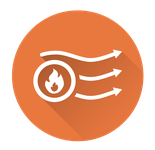Heat Hazards
Protecting Workers in Hot Environments
BY BRENDA JACKLITSCH
Heat-related deaths, illnesses, and injuries continue to occur in workplaces, despite efforts at prevention. Data from the Bureau of Labor Statistics show that in 2010 there were 4,190 cases of injury or illness arising from exposure to heat in the workplace that resulted in one or more days of lost work. Both outdoor and indoor workers who are exposed to heat or who work in hot environments are at risk. To address the hazards of heat and hot environments, NIOSH published the Criteria for a Recommended Standard: Occupational Exposure to Heat and Hot Environments in February. The document can be found on the NIOSH website.
Exposure to extreme heat can result in occupational illnesses caused by heat stress, including heat stroke, heat exhaustion, heat syncope, heat cramps, heat rashes, or death. Heat can also increase workers’ risk of injuries: it may result in sweaty palms, fogged-up safety glasses, and dizziness, and it may reduce brain function responsible for reasoning ability, creating additional safety hazards. Other heat injuries, such as burns, may occur as a result of contact with hot surfaces, steam, or fire.
The original NIOSH criteria document on hot environments was published in 1972 and revised in 1986. These publications assessed the potential safety and health hazards encountered in hot environments, regardless of the workplace, and recommended a standard to protect workers from those hazards. Heat-related occupational illnesses and injuries occur in situations where the total heat load (environmental and metabolic) exceeds the body’s ability to remain balanced. In the 1986 document, NIOSH recommended sliding-scale limits based on environmental and metabolic heat loads determined from available relevant scientific data and industry experience.
The experience of recent years, including the response to the Deepwater Horizon oil spill in 2010, has identified the need for updated guidance that reflects current research and findings. While the basic knowledge of heat balance and heat exchange remains largely unchanged, more information is available today on the biological effects of heat, such as the sweating mechanism, water and electrolyte balance, and dietary factors. And while measurements of heat stress have changed little over the years, the revised NIOSH document includes information about bimetallic thermometers and the psychrometric chart. Psychrometric charts, which show the relationships among dry bulb temperature, wet bulb temperature, relative humidity, vapor pressure, and dew point temperature, are especially valuable for assessing the indoor thermal environment.
NIOSH evaluated its Recommended Alert Limits (RALs) for unacclimatized workers and Recommended Exposure Limits (RELs) for acclimatized workers and determined that both limits are still protective (see Figures 1 and 2). Most healthy workers exposed to environmental and metabolic heat below the appropriate NIOSH RALs or RELs will be protected from adverse health effects. However, consideration of the scientific data led to the decision to remove the ceiling recommendations. Many acclimatized workers live and work in temperatures above the ceiling limits without adverse health effects.
WHO IS AT RISK?
Workers who are exposed to extreme heat or who work in hot environments indoors or outdoors, or even those engaged in strenuous physical activities, may be at risk for heat stress. Many risk factors can contribute to heat stress (see Figure 3), and some are more difficult to address than others. High temperatures and humidity, direct sun exposure or radiant heat sources, limited air movement, not drinking enough fluids, physical exertion, PPE and clothing, physical condition, health problems, medications, lack of acclimatization, advanced age, previous heat-related illness—all of these can increase risk of heat-related illness.
Lack of acclimatization is one risk factor that can be eliminated with some planning and effort. Acclimatization can be described as the physiological changes that occur in response to a succession of days of exposure to environmental heat stress. These changes reduce the strain caused by heat stress and enable a person to work with greater effectiveness and with less chance of heat-related illness. A recent article in Morbidity and Mortality Weekly Report showed that most OSHA citations involving heat-related illness or death of workers involved work sites with no program (or with a deficient program) to prevent heat illness. Of these programs, acclimatization was the element most commonly missing. Unacclimatized workers readily show signs of heat stress when exposed to hot environments and have difficulty replacing the water lost in sweat. Acclimatized workers have increased sweating efficiency, stabilized circulation, the ability to perform work at lower core body temperature and heart rate, and increased skin blood flow, all of which aid in heat loss. Knowing whether workers are acclimatized or not is also essential when determining an appropriate NIOSH recommended limit.
Figure 3. Many factors can increase risk of heat-related illness.
PREVENTIVE MEASURES
In most cases, it can be predicted in advance that a job or task will involve heat or a hot environment. Industrial hygienists can lower the risk of heat stress by following the recommendations in NIOSH’s Criteria for a Recommended Standard: Occupational Exposure to Heat and Hot Environments. Some of the updated recommendations are summarized below.
NIOSH Recommended Limits
NIOSH has RALs for unacclimatized workers and RELs for acclimatized workers. The total heat exposure for all workers, whether acclimatized or not, should be controlled so that unprotected healthy workers are not exposed to heat greater than the appropriate RAL or REL. Workers who are wearing clothing or PPE that increases their heat exposure may need additional modifications to be protected from heat stress. To select the appropriate RAL or REL, the industrial hygienist should assess the environmental heat using the Wet Bulb Globe Thermometer (WBGT) method or another technique to estimate the WBGT values. Environmental heat measurements should be made at least hourly, during the hottest portion of each work shift, during the hottest months of the year, and when a heat wave occurs or is predicted. If two such sequential measurements exceed the applicable RAL or REL, then work conditions should be modified until two sequential measures are in compliance.
Environmental and Metabolic Heat
Each worker’s metabolic heat must be estimated to determine whether the total heat exposure exceeds the applicable RAL or REL. Whenever the combination of measured environmental and screening-estimated metabolic heat exceeds the applicable RAL or REL, the metabolic heat production should be measured using indirect calorimetry or an equivalent method. Metabolic heat rates should be determined for a one-hour time-weighted average per task that includes all activities engaged in during each period of analysis and all scheduled and nonscheduled rest periods. Physiologic monitoring (of heart rate, core body temperature, and body water loss, for example) may be used as an alternative to determining the environmental and metabolic heat.
Medical Monitoring Program
A medical monitoring program should be instituted for all workers who are or may be exposed to heat stress above the RAL, whether they are acclimatized or not. This program is intended to prevent adverse outcomes and to identify early signs or symptoms that may be related to heat-related illness. All medical evaluations and procedures should be performed by or under the direction of the responsible healthcare provider at no cost to workers, including preplacement medical evaluations of prospective workers and periodic evaluations of workers on the job, as well as a plan for monitoring workers.
For the preplacement medical evaluation, all prospective workers should be considered unacclimatized. At minimum, the preplacement medical evaluation should include work and medical history; physical examination; assessment of the use of therapeutic drugs, over-the-counter medications, supplements, alcohol, or caffeine; assessment of obesity; and assessment of the worker’s ability to wear or use any required protective clothing and equipment. In addition, periodic medical evaluations should be made available at least annually to all workers who may be exposed to heat stress exceeding the RAL.
Heat-related Sentinel Health Events
Data related to the occurrence and distribution of adverse health effects in work populations at risk for heat injury or illness should be collected and analyzed. Additional information necessary for prevention and control measures includes workplace modifications; identification of highly susceptible workers; data on the occurrence or recurrence in the same worker; distribution in time, place, and person of heat-related adverse effects; and environmental or physiologic measurements related to heat. This information should be obtained for each workplace.
PPE and Clothing
Engineering controls and safe work practices can ensure that workers’ exposure to heat stress is maintained at or below the applicable RAL or REL. If the total heat stress exceeds the RAL or REL, the employer should provide workers with protective equipment and clothing, such as water-cooled garments, air-cooled garments, ice-packet vests, wetted over-garments, and heat-reflective aprons or suits.
Training
All workers (and their supervisors) who work in areas where there is reasonable likelihood of heat injury or illness should participate in training programs. Training should include information on heat stress hazards; predisposing factors, signs, and symptoms; and first aid. Heat stroke in particular should be discussed, because the characteristics of the individual (age and health status), type of activity (sedentary versus strenuous exertion), and symptoms (sweating versus dry skin) vary between the classic and exertional classifications. Refresher training is often needed in the workplace, especially regarding symptoms; while some of the common public health messaging focuses on classic heat stroke, workers are at higher risk for exertional heat stroke.
Proper precautions for work in hot areas, and the workers’ responsibilities for following proper work practices and control procedures, should be reviewed. This should include instructions to immediately report to their supervisor any signs or symptoms of heat-related illness. Training should cover the effects of therapeutic drugs, over-the-counter medications, alcohol, or caffeine that may reduce heat tolerance and increase the risk of illness. Proper use of PPE and clothing should also be explained or demonstrated, and workers should be included in discussions regarding cultural attitudes toward heat stress. For example, some workers might think, incorrectly, that an individual can be “hardened” against the requirement for fluids when exposed to heat by deliberately becoming dehydrated before work on a regular basis. It is important to break down these myths and provide facts to prevent injury or illness. In addition, workers should have access to a heat stress safety data sheet containing emergency and first aid procedures, and notes to the responsible healthcare provider regarding classification, medical aspects, and prevention of heat injury and illness.
Control of Heat Stress
Heat stress can be reduced by implementing engineering controls, where feasible, to modify metabolic heat production or heat exchange through convection, radiation, or evaporation. A written program should be established to reduce heat exposures to or below the applicable RAL or REL by means of engineering and work practice controls. Examples of engineering controls might include those that aim to increase air velocity; reflective or heat-absorbing shielding or barriers; and reduction of steam leaks, wet floors, or humidity. Work practice controls include:
- limiting time the worker spends each day in the heat by decreasing exposure time, increasing recovery time spent in a cool environment, or both
- reducing the metabolic demands of the job (for example, through mechanization or use of special tools, or increasing the number of workers per task)
- instituting a heat acclimatization plan and increasing physical fitness
- training supervisors and workers to recognize early signs and symptoms of heat illnesses and to administer first aid
- implementing a buddy system where workers observe each other for early signs and symptoms of heat intolerance
- in certain situations, requiring workers to conduct self-monitoring, and creating a work group (comprising workers, a qualified healthcare provider, and a safety manager) to make decisions on self-monitoring options and standard operating procedures
- providing adequate amounts of cool, potable water near the work area and encouraging all workers who have been in the heat for up to 2 hours and involved in moderate work activities to drink a cup of water (about 8 oz.) every 15–20 minutes
If these controls aren’t sufficient to reduce exposures to or below the applicable limit, then they should be supplemented with the use of clothing or equipment that is heat-protective or which provides auxiliary body cooling—for example, water-cooled garments, air-cooled garments, cooling vests, and wetted over-garments. In addition, a heat alert program should be implemented whenever the weather service forecasts that a heat wave is likely to occur in the following days.
FOR ADDITIONAL INFORMATION
At work sites where heat is a hazard, industrial hygienists should review the full recommendations available in the NIOSH criteria document and become familiar with the many risk factors associated with heat-related illnesses. For more information on heat stress and educational products suitable for safety and health professionals, employers, and workers, check the NIOSH Heat Stress Workplace Safety and Health Web topic page.
BRENDA JACKLITSCH, MS, is a health scientist in the NIOSH Education and Information Division and project officer for the NIOSH Criteria for a Recommended Standard: Occupational Exposure to Heat and Hot Environments. She can be reached at gwe6@cdc.gov.
Resources
Bureau of Labor Statistics: “Occupational Outlook Handbook, 2010–2011” (2011).
CDC/NIOSH: “Workplace Safety and Health Topics: Heat Stress” (February 2016).
Morbidity and Mortality Weekly Report: “Heat illness and death among workers: United States, 2012–2013” (August 2014).
NIOSH: Criteria for a Recommended Standard: Occupational Exposure to Heat and Hot Environments (February 2016).
Chronic Kidney Disease Outbreak:
Is Heat Stress to Blame?
By Ed Rutkowski
Tens of thousands of agricultural workers in Central America, India, and Sri Lanka are suffering from a mysterious form of chronic kidney disease (CKD), referred to in medical literature as CKDu, or chronic kidney disease of unknown etiology. Unlike CKD, which primarily afflicts the elderly, CKDu is typically observed in working-age adults as young as 30. And while research has established diabetes and hypertension as causes of CKD, the causes of CKDu have proven difficult to identify. Heat stress is among the possible causes under investigation, although researchers have also focused on physical exertion, exposure to agrichemicals, and water quality.
As explained in a commentary published in the August 2015 issue of BMC Nephrology, “none of the occupational or environmental exposures that have been implicated in previous outbreaks of nephropathy have been established as sole risk factors in the current outbreaks. Thus, multifactorial or novel risks must be considered.”
The article in BMC Nephrology is available to the public. Two of the many sources of information about CKDu are “Chronic Kidney Disease of Unknown Etiology in Sri Lanka: Quest for Understanding and Global Implications,” published by RTI International (PDF); and “Chronic Kidney Disease of Unknown Etiology in Agricultural Communities” in MEDICC Review (PDF). To access coverage of CKDu by media organizations, visit the Web page of The Synergist Newswire and search on “chronic kidney disease.”
ED RUTKOWSKI is editor in chief of The Synergist. He can be reached at (703) 846-0734 or erutkowski@aiha.org.

Tap on the graphic below to open a larger version in your browser.
Tap on the graphics below to open a larger version in your browser.
Figures 1 and 2. NIOSH RALs for unacclimatized workers (left) and RELs for acclimatized workers (right) are sliding-scale limits based on environmental and metabolic heat loads.
thesynergist | TOC | NEWSWATCH | DEPARTMENTS | COMMUNITY



Although the print version of The Synergist indicated The IAQ Investigator's Guide, 3rd edition, was already published, it isn't quite ready yet. We will be sure to let readers know when the Guide is available for purchase in the AIHA Marketplace.
My apologies for the error.
- Ed Rutkowski, Synergist editor
Disadvantages of being unacclimatized:
- Readily show signs of heat stress when exposed to hot environments.
- Difficulty replacing all of the water lost in sweat.
- Failure to replace the water lost will slow or prevent acclimatization.
- Increased sweating efficiency (earlier onset of sweating, greater sweat production, and reduced electrolyte loss in sweat).
- Stabilization of the circulation.
- Work is performed with lower core temperature and heart rate.
- Increased skin blood flow at a given core temperature.
- Gradually increase exposure time in hot environmental conditions over a period of 7 to 14 days.
- For new workers, the schedule should be no more than 20% of the usual duration of work in the hot environment on day 1 and a no more than 20% increase on each additional day.
- For workers who have had previous experience with the job, the acclimatization regimen should be no more than 50% of the usual duration of work in the hot environment on day 1, 60% on day 2, 80% on day 3, and 100% on day 4.
- The time required for non–physically fit individuals to develop acclimatization is about 50% greater than for the physically fit.
- Relative to the initial level of physical fitness and the total heat stress experienced by the individual.
- Can be maintained for a few days of non-heat exposure.
- Absence from work in the heat for a week or more results in a significant loss in the beneficial adaptations leading to an increase likelihood of acute dehydration, illness, or fatigue.
- Can be regained in 2 to 3 days upon return to a hot job.
- Appears to be better maintained by those who are physically fit.
- Seasonal shifts in temperatures may result in difficulties.
- Working in hot, humid environments provides adaptive benefits that also apply in hot, desert environments, and vice versa.
- Air conditioning will not affect acclimatization.
Acclimatization in Workers
In 2012–2013, OSHA issued twenty citations for heat illness, including thirteen fatalities. Most of the workers in these cases were working outdoors, performing tasks such as collecting waste, paving asphalt, delivering mail, and roofing. Of these cases, only one involved an employer who had implemented a work-rest cycle, and none had an acclimatization program.

